As a fellow game developer, you might have new thoughts and ideas every day. Sometimes you may have an exact concept in mind, the one you will follow till it’s done. But sometimes the concept in your mind is pretty vague and abstract. And in that case, you will either accept the first thing that came to your mind, or, like we did, change your mind – a gazillion times, resulting in an array of unrealized realities that will never have their chance to live. Gazillion is a long read. So sit tight, and maybe get a cup of tea if you’re into that.
It all started almost a year ago, in February 2015.
Our small 8 person game dev studio released a game title, it did kind of OK in terms of revenue, and it was time for us to think – what comes next.
After 2 weeks of meetings, we had some points outlined. Our previous title was a cookie clicker game, so we wanted to make something very different, but also to use all we learned from our previous experience. Besides, we wanted something that had a deep storyline. We also talked about this weird idea of “towers”, as in: we wanted to make something that had huge towers in it. Towers that you climb and explore. And thus, our first codename “Tobby” was born.
Tobby
There was something strongly romantic and emotional about empty towers rising up in the sky. Rising so high that you can’t even see where they end, as they go beyond clouds. A good eye could probably catch that we were strongly inspired by games like Journey and Monument Valley, as well as somewhat influenced by a certain anime film, “Spirited Away”. We envisioned a very deep story behind this universe filled with empty towers. I still have a many paged manuscript on my hard drive telling a story of this world and its protagonist.
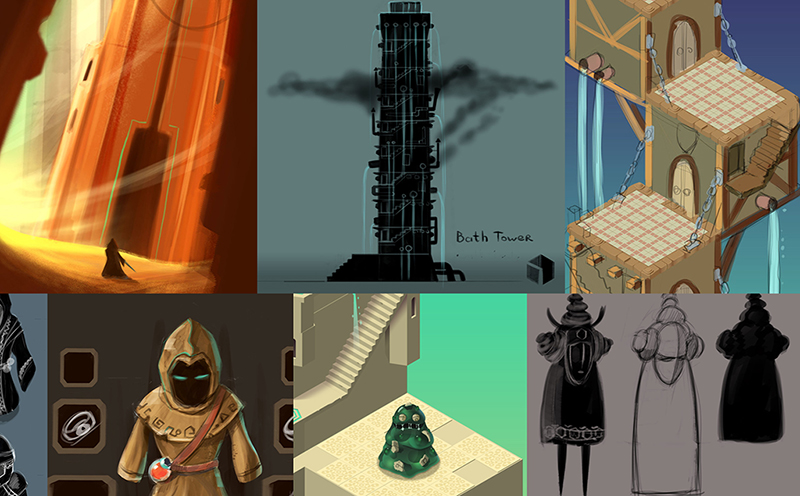
I was really happy about the concept and the only bothering part was that it was still a sort of a cookie clicker in a sense that a player would climb the tower, meet new monsters on their way and kill them one by one by tapping on them, while the player’s stats would continuously grow. Classic “simplified” RPG concept. Other issue was that there was no way to have an actual “player” character inside the game. The player was assumed to be behind the camera, which sounded swell in the beginning, but then it started to suck on first prototype. You were getting new equipment items for your character, but there was no way to see them during gameplay. So much for RPG. That also limited the variety of “spells” a character can cast. After simple, fireball, and freeze, there was no more good spells, as most of good spells that come to your mind has something to do with your character, who is NOT visible. And if you don’t have all this things in, how is this different from a simple cookie clicker?
We also couldn’t get the art quite right. Not in 2D. It all boiled down to one fundamental issue. The game we want to make, is not supposed to be in 2D. It would be crippled by 2D. If only you can rotate camera around, if only you can zoom in and out, and have your character walk around the place. Unfortunately we were completely not ready to take on a 3D game. We don’t have a 3d artist. We don’t have the experience. And I just didn’t want to make this great concept “half-made”. So we had to let go. This took around a month, and we even made a small unrelated mini-game just to keep our revenue flowing. And it was time to sit down again to finally figure out what should we do next. again.
Demolisher
Somewhere in March/April we sat down again, this time taking on something completely different. A simulator of a demolition company! Set in modern times, with funny cartoon-ish workers running around and wrecking houses. This really sounded exciting. There was nothing similar on the market, it was basically a reverse-Minecraft, where you just break buildings block by block. We were thinking of having a huge database of famous landmarks to demolish. There were two ways to approach this. One was a physics-based game, where things would stack on top of each other, held together with physics joints. It became instantly clear that this was a bad idea, because in any such configuration you always have a domino effect: you break something important and the whole thing falls apart, just like in real world. Where’s the fun in that?
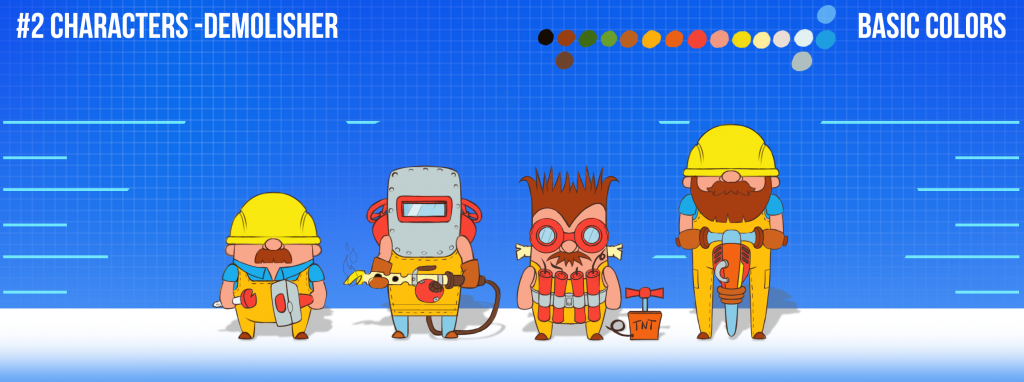
So we thought to go the other way and have a “grid system” where buildings are more Minecraft-like, made from bricks, and things don’t break that easily. Add to that an “HP” concept to each block, and make some blocks stronger than others (e.g., steel is stronger than wood), and it was easy to see how this all could work out. So we started making a prototype!
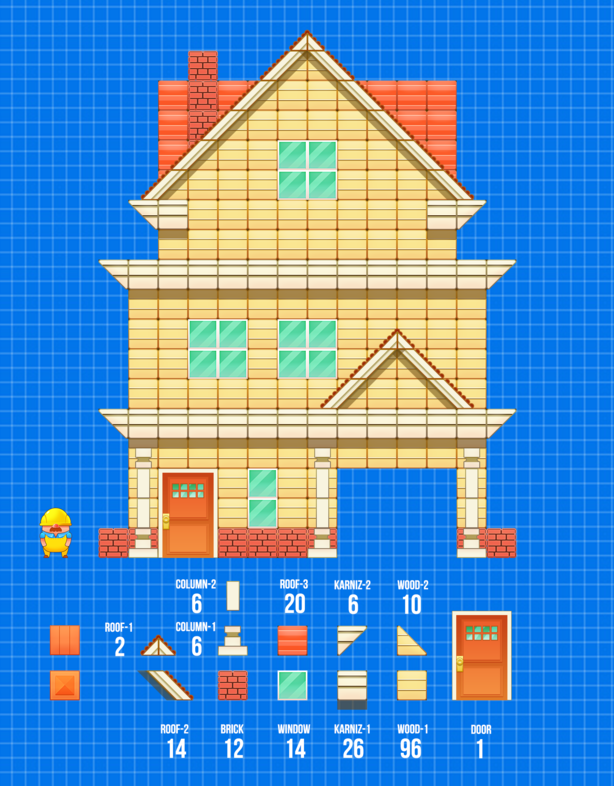 One week in, and we had a level design process of making a classic American style house. That’s when the first problems came forth: windows needed to be on top of the walls, the roof should have had both a back and a front, and thus it meant we really needed some kind of “depth”; so we added layers. With that out of the way, the first prototype was ready, and we played it! And boy, did it suck. Turned out that simple random tapping on the screen converted a good looking house into a jigsaw puzzle, with pieces missing here and there. So all you needed to do was keep tapping until the picture got uglier and eventually disappeared. You know when you blow a dynamite in Minecraft, and your super cool house looks like shit? That’s how 90% of this game looked.
One week in, and we had a level design process of making a classic American style house. That’s when the first problems came forth: windows needed to be on top of the walls, the roof should have had both a back and a front, and thus it meant we really needed some kind of “depth”; so we added layers. With that out of the way, the first prototype was ready, and we played it! And boy, did it suck. Turned out that simple random tapping on the screen converted a good looking house into a jigsaw puzzle, with pieces missing here and there. So all you needed to do was keep tapping until the picture got uglier and eventually disappeared. You know when you blow a dynamite in Minecraft, and your super cool house looks like shit? That’s how 90% of this game looked.
After another couple of weeks of struggle and trying to fix this, we just gave up. We kept wasting time, and this concept just wasn’t going in the direction we wanted it to go. The picture with awesome demolition crew was so inspiring, but the tiled house.. not so much. We even tried to implement the physics-based idea, but, as initially anticipated, it just looked like Angry Birds wrecked level. Shaky structure just falls apart 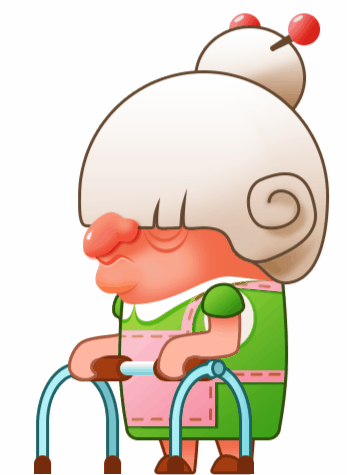 into ugly mess as soon as you touch it, and it’s just a different game. No Demolition.
into ugly mess as soon as you touch it, and it’s just a different game. No Demolition.
So, we had to say goodbye to this idea too. Demolisher, and this angry running grandma lost their chance to be on the worldwide mobile screens. Moving on.
Deep Town
As you probably guessed from the title, we have arrived to the game we are making right now. But, predictably, we changed our minds on this one a LOT. So, if you read so far, don’t give up just yet. Right after Demolisher, we started to think how we can transform this idea into something that will actually work. Two problems needed to be solved: first, breaking blocks should not be random; and second, breaking each block should provide instant gratification. Oh, hey, that’s what mining does! You break ground blocks from top to bottom and you collect loot along the way! Besides, it was always my personal dream to make a game about this “Dwarves mining treasure” thingie for a long long time. So maybe that was the way to go? “Third time’s a charm!”, we thought and went ahead on a new journey. Again.
Mining
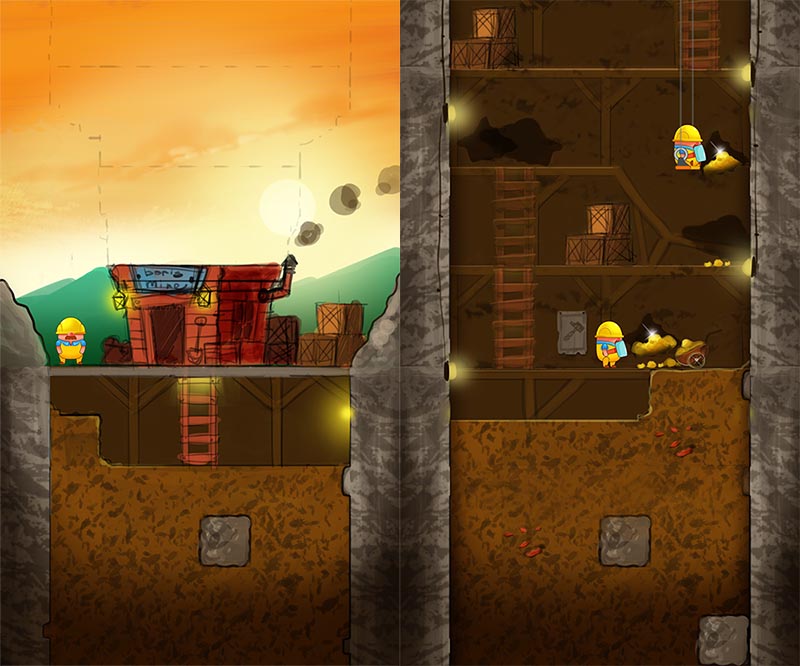 We made the first version and it was basically like a 2D Mine-craft in terms of digging. So we started to think how to build an interesting game around this mechanic. I have added noise functions inspired by No Mans Sky, to make sure no mine is the same. There are actually tons of games like that, nothing original. But what they all lacked for me was – tons of wasted space left after you clear an area. No game cares about this huge empty space the player has created by digging. So we moved to iteration 2.
We made the first version and it was basically like a 2D Mine-craft in terms of digging. So we started to think how to build an interesting game around this mechanic. I have added noise functions inspired by No Mans Sky, to make sure no mine is the same. There are actually tons of games like that, nothing original. But what they all lacked for me was – tons of wasted space left after you clear an area. No game cares about this huge empty space the player has created by digging. So we moved to iteration 2.
Town
We thought: wouldn’t it be great to make things inside the mine? What if each time you dig deep enough to clear an area, you can build things in it. An underground city of sorts. And that was a good idea. Not only that, but we remembered our previous obsession with towers and thought, well, why only build inside the mine shaft, if you can also build on top of it. And the game slowly started shifting from just a “tapping & mining” game, into something more “economical”. It started shifting into “strategy” genre of sorts.
Grids and Tiles
We couldn’t really decide on the mining part again. At first we wanted to use blocks to visually hint what’s inside, and that was boring to play but good looking. Then we removed that and it was exciting to play but ugly. We tried breaking ground with horizontal rows, then we tried with vertical pillars. We tried with blocks falling when there is no block under it, we tried making a mini game from the mining. We tried adding archeological findings there, then we tried adding a timer to see if you can get to a block you want in time. Weirdly enough after almost 30 different things tried there, we stopped on a very simple idea of just ditching square tiles, and clearing ground row by row. Worked like a charm. Sometimes it’s important to not overthink it.

Auto mining Buildings
We created tons of buildings that you can have in the game, from smelting to crafting, but there was this one building that we changed 8 times! It was an auto-mining floor. Check this out.
We changed bunch of other stuff too, but I think we can probably stop here.
Summary
That was a long read huh? (It was also a long to write, too) Thanks for staying so far!
You may ask, what’s the moral of the story? And honestly, I don’t know, but it’s probably safe to say that changing mind so often speaks for lack of experience. A more experienced game developer would have seen all the issues much, much earlier, thus not having to change things all over and over again. But more importantly, I guess there’s something else lurking in here: the fact that it would have been much worse to just stop trying at some point and simply settle somewhere in the middle. I think it’s important to search for the perfect solution that just fits right, even if it sometimes takes ridiculous amount of time.
It’s November 2016, and we have come a long way. Deep Town is in full force development, with great story, and awesome bots digging ground to its core. I hope we don’t change the game that much anymore, as we really like what we have so far. But.. you never know 🙂
As for all this other unrealized games, I’d like to believe that somewhere in the parallel universe, we figured out a perfect way to make them right, and they are currently out there, being played by millions of parallel “us”. Who knows, maybe the alternate-you is exploring the mesmerizing empty tower universe of “that tower game” right now.